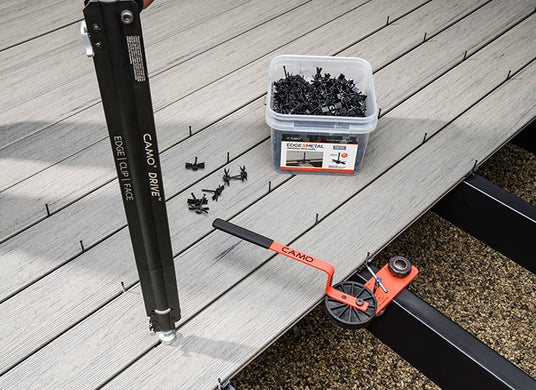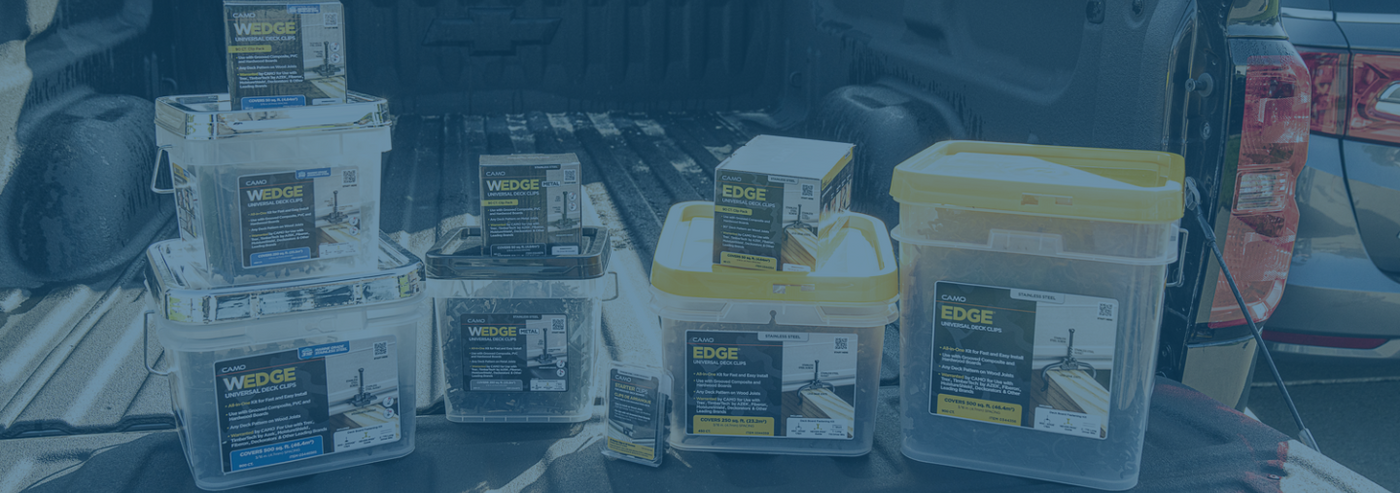Browse Our Selections
The CAMO Guarantee
For further peace of mind, our products are backed by a CAMO Warranty. ClipDRIVE, DRIVE, and LEVER all have a one-year tool warranty, while CAMO Universal Deck Clips are warranted for use in leading grooved deck boards, including Trex®, TimberTech® by AZEK®, Fiberon®, Deckorators®, and more. That means you can confidently use CAMO on every install.
How it works
Comparison Table
| Feature | Camo Edge Fasteners | Traditional Screws | Hidden Clip Systems |
|---|---|---|---|
| Visible Fasteners | ✗ | ✓ | ✗ |
| Installation Speed | Fast | Slow | Medium |
| Holding Strength | High | Medium | Medium |
| Board Replacement | ✓ | ✗ | Moderate |

Experience Faster and Easier Decking Installs
With the included NEVER-MISS Guide or CAMO's innovative tools like ClipDRIVE™, you can fasten clips while standing up, achieving up to 5X faster installation. Lay out your boards, lock them in place with LEVER tools, and enjoy a seamless decking experience.
Frequently Asked Questions
Can you use CAMO screws on pressure treated lumber?
Can you use CAMO screws on pressure treated lumber?
Yes, you can use CAMO screws on pressure treated lumber, as they are specifically designed for this purpose. CAMO Edge Screws provide a hidden fastening look, while CAMO Collated Face Screws are ideal for securing pressure treated boards without causing splits or cracks. Both types of screws can be installed efficiently using the CAMO DRIVE™ tool, which allows for easy and quick fastening while standing up, enhancing productivity on the job site. For optimal results, it’s recommended to place wet pressure treated boards tightly together before fastening, as they will shrink over time.
Are hidden deck fasteners worth it?
Are hidden deck fasteners worth it?
Hidden deck fasteners can be worth it, depending on your specific needs and preferences. Many users appreciate the clean, professional look that hidden fasteners provide, as they eliminate visible screw holes and enhance the aesthetic of the deck.
However, some experiences suggest that hidden fasteners can complicate repairs and may require additional surface screws for stability. For instance, while some users have found success with brands like Camo, others have reported difficulties with certain systems, particularly when needing to replace boards in the future. Unlike traditional fasteners, CAMO's hidden deck fastening system installs screws at a 45-degree angle, providing a stronger hold that minimizes the risk of boards splitting or warping over time. The precision-engineered CAMO Marksman tools facilitate quick installation without the need for pre-drilling, significantly reducing labor time and effort. Additionally, CAMO fasteners are compatible with a wide range of decking materials and are designed to prevent the complications often associated with hidden fasteners, such as board movement and maintenance challenges.
How many screws per sq ft of deck?
How many screws per sq ft of deck?
For decking installation, the recommended number of screws per square foot varies based on the deck board size and joist spacing.
Are CAMO deck screws structural?
Are CAMO deck screws structural?
Yes, CAMO deck screws are structural and designed to meet rigorous building codes. They offer a full line of high-performing, code-compliant structural screws suitable for various deck and framing applications. Engineered for efficiency, CAMO screws do not require pre-drilling, feature a Type 17 slash point to reduce friction and drive time, and provide a large flat head for enhanced pull-through holding power.
How do you install CAMO deck screws?
How do you install CAMO deck screws?
To install CAMO deck screws:
- Prepare: Ensure your deck frame is ready with CAMO screws and tools.
- Align: Position the first board on the frame.
- Use Marksman Tool: Secure the tool on the board’s edge to create a 3/16 inch gap.
- Insert Screws: Load CAMO screws into the tool, guiding them at a 45-degree angle.
- Drill: Drive the screws in using a drill; teamwork can speed up the process.
- Check Stability: Ensure each board is secure before moving on.
This method ensures a sturdy deck. For a visual guide, check out this video tutorial.






